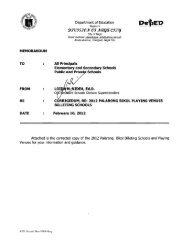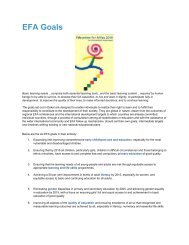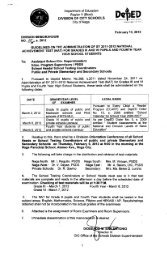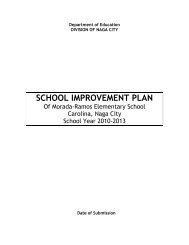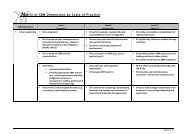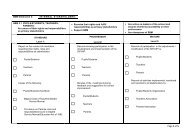Casiguran Technical Vocational School ... - DepEd Naga City
Casiguran Technical Vocational School ... - DepEd Naga City
Casiguran Technical Vocational School ... - DepEd Naga City
Create successful ePaper yourself
Turn your PDF publications into a flip-book with our unique Google optimized e-Paper software.
<strong>Casiguran</strong> <strong>Technical</strong> <strong>Vocational</strong> <strong>School</strong><br />
<strong>Casiguran</strong>, Sorsogon
Background & Motivation for Study<br />
Below national and international<br />
standard performance in Science<br />
Results of Education Researches<br />
in Physics<br />
Need for a new, effective and<br />
innovative teaching-learning<br />
approach in Science that focus<br />
on hands-on and minds-on<br />
activities
Conceptual Framework<br />
ILD’s Procedure<br />
1.Presentation<br />
2.Prediction<br />
3.Peer Discussion<br />
4.Demonstration<br />
5.Solicitation of observation<br />
6.Consolidation of observation<br />
7.Teacher-led discussion<br />
8.Application
Statement of the Problem<br />
1. What are the students’ conceptual<br />
understandings on Reflection and<br />
Refraction of Light before and after<br />
ILD’s<br />
2. Is there a significant increase on<br />
the conceptual understanding<br />
between those students exposed to<br />
ILD’s and those exposed to TLM<br />
3. What are students’ views of ILD’s<br />
as new teaching approach
Research Design<br />
Experimental pretest-posttest<br />
control design<br />
Respondents<br />
2 classes of 4 th Year students at<br />
Magallanes NHS, Sorsogon, S.Y. 2009-2010<br />
Experimental Group (ILD)<br />
Control Group (TLM)<br />
Research Instruments<br />
Validated researcher-made test<br />
-Test of reliability : Cronbach’s Alpha (0.312)<br />
ILD’s Lessons / TLM (RBEC LP’s)<br />
Opinionnaire
Analysis of Students’ Conceptual<br />
Understanding Prior and After Instruction<br />
Percentages were determined for responses<br />
in pretest and posttest of both groups.<br />
30<br />
Correct responses reflect conceptual<br />
0<br />
understanding. Incorrect responses reflect<br />
conceptual misunderstanding/ and or<br />
alternative conceptions<br />
Prediction sheets were analyzed<br />
Performance Mastery Level (RBEC)<br />
PL = (mean / no. of items) x 100%
Problem 1 Students’ Conceptual Understanding<br />
Above Satisfactory Mastery Level of Two Groups in<br />
Different Concepts in Reflection and Refraction<br />
Concept<br />
Pretest Posttest<br />
TLM ILD TLM ILD<br />
Image Formation in Mirrors ⁄<br />
1. distinguishing characteristics among plane and<br />
spherical mirrors ⁄ ⁄<br />
2. second law of reflection applies in both plane<br />
and curved mirrors ⁄ ⁄<br />
3. image formed by a concave mirror depends on<br />
the location of the object in front of it ⁄ ⁄<br />
4. observer’s speed as he approach his/her image<br />
is twice his speed ⁄<br />
5. distance of the observer to his/her image is<br />
twice as his/her distance from the mirror /<br />
6. plane mirror produces an image that is virtual<br />
and laterally inverted ⁄
Students’ Conceptual Understanding<br />
Above Satisfactory Mastery Level of Two Groups in<br />
Different Concepts in Reflection and Refraction<br />
Pretest Posttest<br />
Concept<br />
TLM ILD TLM ILD<br />
Laws of Reflection of Light<br />
1. ray tracing the path of light from object<br />
to observer ⁄<br />
Refraction of Light<br />
1. the direction light travels changes when<br />
the medium through it travels changes ⁄<br />
2. when an object is viewed through a<br />
transparent material, the object is not<br />
seen exactly where it is located ⁄<br />
Snell's Law of Refraction<br />
1. determining the index of refraction ⁄
Problem 2 On the Effectiveness of ILD’s<br />
Statistical Analysis<br />
One-tailed t-test,<br />
α = 0.05, df = 106<br />
hypothesized mean diff (μ ILD - μ TLM = 0),<br />
t-critical one-tail (t tab =1.66).<br />
normalized gain or the g – factor (Hake, 1998)<br />
Ratio of actual average gain to the maximum<br />
possible average gain<br />
g = Posttest Score − Pretest Score x 100%<br />
Maximum Score − Pretest Score
Statistical Analysis on the Effectiveness of ILD<br />
Test of Differences in Pre Test Mean Scores<br />
Group<br />
N<br />
Mean<br />
Score<br />
Mean<br />
Diff t tab t-value Interpretation<br />
TLM 54 6.56<br />
Not<br />
ILD 54 6.56 0.00 1.66 0.00 Significant<br />
Maximum score = 25
Statistical Analysis on the Effectiveness of ILD<br />
Test of Differences in Hake Gain Scores by Topic<br />
Highest<br />
PostTest<br />
Mean<br />
Normalized<br />
Gain<br />
Topic<br />
Possible<br />
Score ILD TLM ILD TLM<br />
t-value Interpretation<br />
Laws of<br />
Reflection 4 2.31 1.43 0.05 0.03 1.61 not significant<br />
Image<br />
Formation<br />
in Mirrors 15 7.63 6.54 3.37 2.09 2.55 significant<br />
Refraction 4 2.72 1.79 0.59 0.08 5.22 significant<br />
Snell's Law 2 1.02 0.65 0.31 -0.06 3.27 significant<br />
Overall 25 13.69 10.37 0.38 0.2 5.72 significant<br />
df = 106 t tab = 1.66<br />
α = 0.05
Statistical Analysis on the Effectiveness of ILD<br />
Test of Differences in Pre Test, Post Test<br />
and Hake Gain Scores<br />
Group<br />
N<br />
Pretest<br />
mean<br />
t-<br />
value<br />
Posttest<br />
mean<br />
Hake<br />
gain<br />
t tab<br />
t-<br />
value Interpretation<br />
ILD 54 6.56<br />
13.69 0.27<br />
TLM 54 6.56 0.00 10.37 0.14<br />
1.66 6.62 Significant<br />
df = 106 t tab = 1.66<br />
α = 0.05
Problem 3 Students’ View on ILDs<br />
ILD’s teaching procedure result to<br />
better understanding.<br />
Procedure of the ILD was easy to<br />
follow<br />
ILDs provide greater opportunity<br />
to express their ideas<br />
Lessons were better remembered<br />
because they where asked to write the<br />
result of the demonstration.
Conclusion<br />
The effectiveness of the Traditional Lecture<br />
Method (TLM) and the Interactive Lecture<br />
Demonstration (ILD) as approaches to teaching<br />
reflection and refraction of light was compared.<br />
Two equal groups of students were each<br />
exposed to TLM (control group) and ILD<br />
(experimental group) instructions. The same<br />
pretest and posttest were used to investigate<br />
the change in the mastery level of the<br />
respondents.<br />
On the onset of study, both group exhibit<br />
comparable performance considering their<br />
responses to the pretest.
Conclusion<br />
Both groups have below satisfactory level of<br />
mastery level on conceptual understanding on<br />
concepts on reflection and refraction in pre test<br />
Result of posttest and normalized gain<br />
indicates improvement in the conceptual<br />
understanding of both groups<br />
Results showed that there is a statistically<br />
significant increase in the mean gain of scores<br />
of the ILD group compared to the TLM group in<br />
general.<br />
Students exposed to ILD method showed positive<br />
attitude toward the activities of the ILD's.
The use of Interactive<br />
Engagement were on average,<br />
more than twice as effective as<br />
traditional courses in promoting<br />
conceptual change…<br />
- Richard Hake
Thank you…




